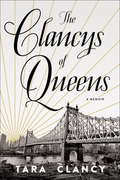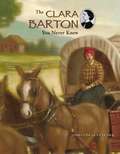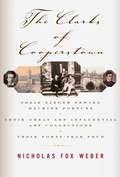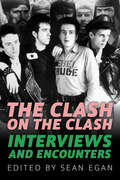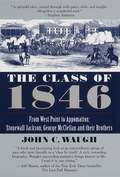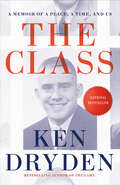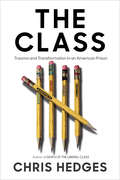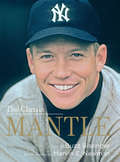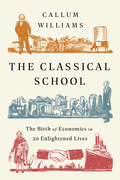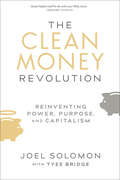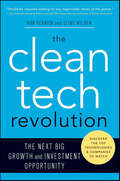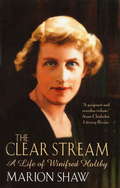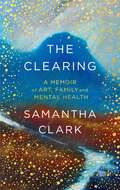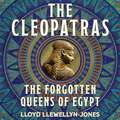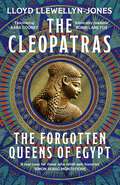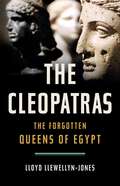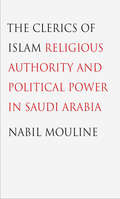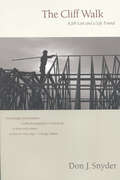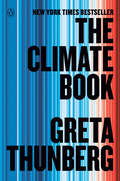- Table View
- List View
The Clancys of Queens: A Memoir
by Tara ClancyFifth-generation New Yorker, third-generation bartender, and first-generation author Tara Clancy was raised in three wildly divergent homes: a converted boat shed in working class Queens, a geriatric commune of feisty, Brooklyn-born Italians, and a sprawling Hamptons estate she visited every other weekend. This childhood triptych comes to life in The Clancys of Queens, an electric, one-of-a-kind memoir. From scheming and gambling with her force-of-nature grandmother, to brawling with eleven-year-old girls on the concrete recess battle yard of MS 172, to hours lounging on Adirondack chairs beside an immaculate croquet lawn, to holding court beside Joey O'Dirt, Goiter Eddy, and Roger the Dodger at her Dad's local bar, Tara leapfrogs across these varied spheres, delivering stories from each world with originality, grit, and outrageous humor. But The Clancys of Queens is not merely an authentic coming-of-age tale or a rowdy barstool biography. Chock-full of characters who escape the popular imaginings of this city, it offers a bold portrait of real people, people whose stories are largely absent from our shelves. Most crucially, it captures--in inimitable prose--the rarely-heard voices of New York's working-class women. With a light touch but a hard hit, The Clancys of Queens blends savvy and wit to take us on an unforgettable strata-hopping adventure.From the Hardcover edition.
The Clara Barton You Never Knew
by James Lincoln CollierExplores the childhood, character, and influential events that shaped the life of the Civil War nurse who went on to found the American Red Cross. Includes bibliographical references and index.
The Clarks of Cooperstown
by Nicholas Fox WeberNicholas Fox Weber, author of the acclaimed Patron Saints ("Exhilarating avant-garde entertainment"--Sam Hunter, The New York Times Book Review) and Balthus ("The authoritative account of his life and work"--Michael Ravitch, Newsday), gives us now the idiosyncratic lives of Sterling and Stephen Clark--two of America's greatest art collectors, heirs to the Singer sewing machine fortune, and for decades enemies of each other. He tells the story, as well, of the two generations that preceded theirs, giving us an intimate portrait of one of the least known of America's richest families.He begins with Edward Clark--the brothers' grandfather, who amassed the Clark fortune in the late-nineteenth century--a man with nerves of steel; a Sunday school teacher who became the business partner of the wild inventor and genius Isaac Merritt Singer. And, by the turn of the twentieth century, was the major stockholder of the Singer Manufacturing Company.We follow Edward's rise as a real estate wizard making headlines in 1880 when he commissioned Manhattan's first luxury apartment building. The house was called "Clark's Folly"; today it's known as the Dakota.We see Clark's son--Alfred--enigmatic and famously reclusive; at thirty-eight he inherited $50 million and became one of the country's richest men. An image of propriety--good husband, father of four--in Europe, he led a secret homosexual life. Alfred was a man with a passion for art and charity, which he passed on to his four sons, in particular Sterling and Stephen Clark.Sterling, the second-oldest, buccaneering and controversial, loved impressionism, created his own museum in Williamstown, Massachusetts--and shocked his family by marrying an actress from the Comédie Française. Together the Sterling Clarks collected thousands of paintings and bred racehorses.In a highly public case, Sterling sued his three brothers over issues of inheritance, and then never spoke to them again.He was one of the central figures linked to a bizarre and little-known attempted coup against Franklin Delano Roosevelt's presidency. We are told what really happened and why--and who in American politics was implicated but never prosecuted.Sterling's brother--Stephen--self-effacing and responsible--became chairman and president of the Museum of Modern Art and gave that institution its first painting, Edward Hopper's House by the Railroad. Thirteen years later, in an act that provoked intense controversy, Stephen dismissed the Museum's visionary founding director, Alfred Barr, who for more than a decade had single-handedly established the collection and exhibition programs that determined how the art of the twentieth century was regarded.Stephen gave or bequeathed to museums many of the paintings that today are still their greatest attractions.With authority, insight, and a flair for evoking time and place, Weber examines the depths of the brothers' passions, the vehemence of their lifelong feud, the great art they acquired, and the profound and lasting impact they had on artistic vision in America.From the Hardcover edition.
The Clarks of Cooperstown
by Nicholas Fox WeberNicholas Fox Weber, author of the acclaimed Patron Saints ("Exhilarating avant-garde entertainment"--Sam Hunter, The New York Times Book Review) and Balthus ("The authoritative account of his life and work"--Michael Ravitch, Newsday), gives us now the idiosyncratic lives of Sterling and Stephen Clark--two of America's greatest art collectors, heirs to the Singer sewing machine fortune, and for decades enemies of each other. He tells the story, as well, of the two generations that preceded theirs, giving us an intimate portrait of one of the least known of America's richest families.He begins with Edward Clark--the brothers' grandfather, who amassed the Clark fortune in the late-nineteenth century--a man with nerves of steel; a Sunday school teacher who became the business partner of the wild inventor and genius Isaac Merritt Singer. And, by the turn of the twentieth century, was the major stockholder of the Singer Manufacturing Company.We follow Edward's rise as a real estate wizard making headlines in 1880 when he commissioned Manhattan's first luxury apartment building. The house was called "Clark's Folly"; today it's known as the Dakota.We see Clark's son--Alfred--enigmatic and famously reclusive; at thirty-eight he inherited $50 million and became one of the country's richest men. An image of propriety--good husband, father of four--in Europe, he led a secret homosexual life. Alfred was a man with a passion for art and charity, which he passed on to his four sons, in particular Sterling and Stephen Clark.Sterling, the second-oldest, buccaneering and controversial, loved impressionism, created his own museum in Williamstown, Massachusetts--and shocked his family by marrying an actress from the Comédie Française. Together the Sterling Clarks collected thousands of paintings and bred racehorses.In a highly public case, Sterling sued his three brothers over issues of inheritance, and then never spoke to them again.He was one of the central figures linked to a bizarre and little-known attempted coup against Franklin Delano Roosevelt's presidency. We are told what really happened and why--and who in American politics was implicated but never prosecuted.Sterling's brother--Stephen--self-effacing and responsible--became chairman and president of the Museum of Modern Art and gave that institution its first painting, Edward Hopper's House by the Railroad. Thirteen years later, in an act that provoked intense controversy, Stephen dismissed the Museum's visionary founding director, Alfred Barr, who for more than a decade had single-handedly established the collection and exhibition programs that determined how the art of the twentieth century was regarded.Stephen gave or bequeathed to museums many of the paintings that today are still their greatest attractions.With authority, insight, and a flair for evoking time and place, Weber examines the depths of the brothers' passions, the vehemence of their lifelong feud, the great art they acquired, and the profound and lasting impact they had on artistic vision in America.From the Hardcover edition.
The Clash on Clash: Interviews and Encounters
by Sean EganThe Clash thought they could change the world. They never did, but they created some of the greatest rock music of all time in the attempt.Clash interviews were mesmerizing. Infused with the messianic spirit of punk, the Clash engaged with the press like no rock group before or since, treating interviews almost as addresses to the nation. Their pronouncements were welcomed but were hardly uncritically reported. The Clash's back pages are voluminous, crackle with controversy, and constitute a snapshot of a uniquely thoughtful and fractious period in modern history. Included in this compendium are the Clash's encounters with the most brilliant music writers of their time, including Lester Bangs, Nick Kent, Mikal Gilmore, Chris Salewicz, Charles Shaar Murray, Mick Farren, Kris Needs, and Lenny Kaye.Whether it be their audience with the (mainly) simpatico likes of punk fanzine Sniffin' Glue, their testy encounters with the correspondents of pious UK weeklies like New Musical Express, Melody Maker, and Sounds, or their friendlier but no less eyebrow-raising conversations with US periodicals like Creem and Rolling Stone, the Clash consistently created copy that lived up to their sobriquet "The Only Band That Matters."
The Class of 1846: From West Point to Appomattox: Stonewall Jackson, George McClellan, and Their Br others
by John WaughNo single group of men at West Point--or possibly any academy--has been so indelibly written into history as the class of 1846. The names are legendary: Thomas "Stonewall" Jackson, George B. McClellan, Ambrose Powell Hill, Darius Nash Couch, George Edward Pickett, Cadmus Marcellus Wilcox, and George Stoneman. The class fought in three wars, produced twenty generals, and left the nation a lasting legacy of bravery, brilliance, and bloodshed.This fascinating, remarkably intimate chronicle traces the lives of these unforgettable men--their training, their personalities, and the events in which they made their names and met their fates. Drawing on letters, diaries, and personal accounts, John C. Waugh has written a collective biography of masterful proportions, as vivid and engrossing as fiction in its re-creation of these brilliant figures and their pivotal roles in American history.From the Trade Paperback edition.
The Class: A Memoir of a Place, a Time, and Us
by Ken DrydenINSTANT NATIONAL BESTSELLER • Shortlisted for the 2024 Speaker&’s Book AwardFrom bestselling author Ken Dryden, a riveting new book.On Tuesday, September 6, 1960, the day after Labour Day, class 9G at Etobicoke Collegiate Institute in a suburb of Toronto assembled for the first time. Its thirty-five students, having written special exams, came to be known as the &“Selected Class.&”They would stay together through high school, with few exceptions. They would spend more than two hundred days a year together. Few had known each other before. Few have been in other than accidental contact in all the decades since.Their ancestors were almost all from working-class backgrounds. Their parents had lived their formative years through depression and war. They themselves were born into a postwar world of new homes, new schools, new churches. New suburbs. Of new classes like this one. Of boundless possibilities.When almost anything seems within reach, what do we reach for?Ken Dryden was one of these thirty-five. In his varied, improbable life, he had wondered often how he had gotten from there to here. How any of us do. He decided to try and find his classmates, to see how they are, what they are doing, how life has been for them. They talked many long hours, in a way they had never talked before. Most had married, some divorced, most have kids, many have grandkids.This is the story of a place, a time, and so much more.
The Class: Trauma and Transformation in an American Prison
by Chris Hedges"This book could change everything. It could change our minds. It could buttress our hearts. It could make graspable why today&’s prisons are contemporary slave plantations. I couldn&’t put it down and I tried." —Alice Walker, author of The Color PurpleA haunting and powerfully moving book that gives voice to the poorest among us and lays bare the cruelty of a penal system that too often defines their lives.In this unforgettable work, Pulitzer Prize-winning journalist Chris Hedges, who brought us War Is a Force That Gives Us Meaning and America, The Farewell Tour, provides an intimate and moving look at the lives of the students he teaches in a maximum-security prison. He and twenty-eight students (who together are serving a combined sentence of 515 years) read and discussed plays by Amiri Baraka, John Herbert, Tarell Alvin McCraney, Miguel Piñero and August Wilson, among others. Together they set out to write an original play drawing on their experiences of poverty, institutionalized racism, police brutality and mass incarceration. (Their play, Caged, would eventually perform to sold-out audiences and be published as a book in 2020.) In The Class, the men—some of whom know they will die in prison—give voice to the struggles of grief, shame, injustice, guilt and generational trauma they and their families have endured, as well as to their hopes and dreams. Hedges chronicles with heart-breaking intimacy the emotional struggle for artistic expression that leads to self-awareness, transformation and redemption. The Class is at once a story of creative triumph and a scorching critique of the racialized poverty that plagues North America and what it does to the most vulnerable.
The Classic Mantle
by Buzz BissingerFilled with stunning photos, this book by the #1 New York Times–bestselling sportswriter tells the story of Mickey Mantle’s legendary career.Mickey Mantle has long been considered one of baseball's most memorable figures—playing his entire eighteen-year baseball career for the New York Yankees (1951-68), winning three American League MVP titles, playing in twenty All-Star games, and winning seven World Series. Today, decades after his retirement, he still holds six World Series records, including most home runs (18). Buzz Bissinger, Pulitzer Prize winner and acclaimed author of Friday Night Lights and Three Nights in August, goes beyond the statistics to bring Mantle to life, and striking photographs by Marvin E. Newman make this book a fitting tribute to Mantle’s career and his lasting impact on the sport of baseball.
The Classic Palmer
by John FeinsteinA portrait of legendary golfer Arnold Palmer from a New York Times–bestselling sportswriter, with numerous photos included. Over a career spanning more than half a century, Arnold Palmer amassed an astounding record of ninety-two worldwide titles, four Masters championships, a US Open crown, and back-to-back British Open victories, truly earning his nickname &“the King&”—as well as a legion of loyal fans who came to be known as &“Arnie&’s Army.&” He exuded a charisma that America loved—and even had a drink named after him. In this chronicle of one of the greatest players ever to swing a club, renowned sportswriter John Feinstein provides a vivid biographical portrait of golf&’s most beloved icon. Accompanied by Walter Iooss&’s superb photographs, The Classic Palmer lets golf lovers travel with Palmer on his journey from amateur to pro, from pro to master, and from master to legend.
The Classical School: The Birth of Economics in 20 Enlightened Lives
by Callum WilliamsA fascinating chronicle of the lives of 20 economists who played major roles in the evolution of global economic thought.What was Adam Smith really talking about when he mentioned the "invisible hand"? Did Karl Marx really predict the end of capitalism? Did Thomas Malthus (from whose name the word "Malthusian" derives) really believe that famines were desirable?In The Classical School, Callum Williams debunks popular myths about these great economists, and explains the significance of their ideas in an engaging way. After reading this book, you will know much more about the very famous (Smith, Ricardo, Mill) and the not-quite-so-famous (Bernard de Mandeville, Friedrich Engels, Jean-Baptiste Say). The book offers an assessment of what they wrote, the impact it had, and the worthiness of their ideas. It's far from the final word on any of these people, but a useful way of understanding what they were all about, at a time when understanding these economic giants is perhaps more important than ever.
The Classification Of Sex: Alfred Kinsey And The Organization Of Knowledge
by Donna DruckerAlfred C. Kinsey’s revolutionary studies of human sexual behavior are world-renowned. His meticulous methods of data collection, from comprehensive entomological assemblies to personal sex history interviews, raised the bar for empirical evidence to an entirely new level. In The Classification of Sex, Donna J. Drucker presents an original analysis of Kinsey’s scientific career in order to uncover the roots of his research methods. She describes how his enduring interest as an entomologist and biologist in the compilation and organization of mass data sets structured each of his classification projects. As Drucker shows, Kinsey’s lifelong mission was to find scientific truth in numbers and through observation—and to record without prejudice in the spirit of a true taxonomist. <p><p> Kinsey’s doctoral work included extensive research of the gall wasp, where he gathered and recorded variations in over six million specimens. His classification and reclassification of Cynips led to the speciation of the genus that remains today. During his graduate training, Kinsey developed a strong interest in evolution and the links between entomological and human behavior studies. In 1920, he joined Indiana University as a professor in zoology, and soon published an introductory text on biology, followed by a coauthored field guide to edible wild plants. <p> In 1938, Kinsey began teaching a noncredit course on marriage, where he openly discussed sexual behavior and espoused equal opportunity for orgasmic satisfaction in marital relationships. Soon after, he began gathering case histories of sexual behavior. As a pioneer in the nascent field of sexology, Kinsey saw that the key to its cogency was grounded in observation combined with the collection and classification of mass data. To support the institutionalization of his work, he cofounded the Institute for Sex Research at Indiana University in 1947. He and his staff eventually conducted over eighteen thousand personal interviews about sexual behavior, and in 1948 he published Sexual Behavior in the Human Male, to be followed in 1953 by Sexual Behavior in the Human Female. <p> As Drucker’s study shows, Kinsey’s scientific rigor and his early use of data recording methods and observational studies were unparalleled in his field. Those practices shaped his entire career and produced a wellspring of new information, whether he was studying gall wasp wings, writing biology textbooks, tracing patterns of evolution, or developing a universal theory of human sexuality.
The Classmates: Privilege, Chaos, and the End of an Era
by Geoffrey DouglasFifty years ago, in the fall of 1957, two thirteen-year-old boys were enrolled at an elite, boys-only New England boarding school. One of them, descended from wealth and eminence, would go on to Yale, then to a career as a navy officer and Vietnam war hero, and finally to the U.S. Senate, from where he would fall just short of the White House. The other was a scholarship student, a misfit giant of a boy from a Pennsylvania farm town who would suffer shameful debasements at the hands of his classmates, then go on to a solitary and largely anonymous life as a salesman of encyclopedias and trailer parts--before dying, alone, twelve months after his classmate's narrow loss on Election Day 2004. It is around these two figures, John Kerry and a boy known here only as Arthur, the bookends of a class of one hundred boys, that Geoffrey Douglas--himself a member of that boarding-school class--builds this remarkable memoir. His portrait of their lives and the lives of five others in that class--two more Vietnam veterans with vastly divergent stories, a federal judge, a gay New York artist who struggled for years to find his place in the world, and Douglas himself--offers a memorable look back to a generation caught between the expectations of their fathers and the sometimes terrifying pulls of a society driven by war, defiance, and self-doubt. The class of 1962 was not so different from any other, with its share of swaggerers and shining stars, outcasts and scholarship students. Its distinction was in its timing: at the precise threshold of the cultural and political upheavals of the late 1960s. The world these boys had been trained to enter and to lead, a world very similar to their fathers', would be exploded and recast almost at the moment of their entrance--forcing choices whose consequences were sometimes lifelong. Douglas's chronicle of those times and choices is both a capsule history of an era and a literary tour de force.
The Clean Money Revolution: Reinventing Power, Purpose, and Capitalism
by Joel Solomon Tyee Bridge“[Joel is] a beloved local financial superhero, and this book is a brilliant roadmap to purposeful investing.” —Catherine Ludgate, Manager of Community Investment, VancityBy 2050, $50 trillion will change hands in North America in the largest generational wealth transfer ever. It will remake the world and be the biggest money-making opportunity in history.“Business as usual,” founded on exploitation and environmental ruin, is over. Climate catastrophe, reactionary politics, and widening inequity have put the world on edge. Meanwhile innovations are shifting the economic ground, and an entire generation is pounding the table for real change. Capitalism is evolving into a force that can restore the planet, transform the global economy, and bring justice to people.Joel Solomon, impact investor and change agent, lays it on the line. The Clean Money Revolution is part memoir of an inspiring thought leader’s journey from presidential campaigner to pioneering investor, part insider’s guide to the businesses remaking the world, and part manifesto for a new vision of profit, power, and purpose.Meet some of the people behind this massive shift, and discover the role you can play in the $50-trillion movement toward true prosperity. A must-read for investors, wealth advisors, aspiring entrepreneurs, and all who want their values and money to work together to transform the future.The Clean Money Revolution is on. Join it!“Good helpful stuff to do with your filthy lucre.” —Margaret Atwood, author of The Handmaid’s Tale“Joel Solomon so eloquently lights the path society needs to take in order to ensure future generations can flourish on a sustainable planet earth.” —Reverend Yearwood, President of the Hip Hop Caucus
The Clean Tech Revolution: The Next Big Growth and Investment Opportunity
by Clint Wilder Ron PernickWhen industry giants such as GE, Toyota, and Sharp and investment firms such as Goldman Sachs are making multibillion-dollar investments in clean technology, the message is clear. Developing clean technologies is no longer a social issue championed by environmentalists; it's a moneymaking enterprise moving solidly into the business mainstream. In fact, as the economy faces unprecedented challenges from high energy prices, resource shortages, and global environmental and security threats, clean tech—technologies designed to provide superior performance at a lower cost while creating significantly less waste than conventional offerings—promises to be the next engine of economic growth.In The Clean Tech Revolution, authors Ron Pernick and Clint Wilder identify the major forces that have pushed clean tech from back-to-the-earth utopian dream to its current revolution among the inner circles of corporate boardrooms, on Wall Street trading floors, and in government offices around the globe. By highlighting eight major clean-tech sectors—solar energy, wind power, biofuels and biomaterials, green buildings, personal transportation, the smart grid, mobile applications, and water filtration—they uncover how investors, entrepreneurs, and individuals can profit from this next wave of technological innovation. Pernick and Wilder shine the spotlight on the winners among technologies, companies, and regions that are likely to reap the greatest benefits from clean tech—and they show you why the time to act is now.Groundbreaking and authoritative, The Clean Tech Revolution is the must-read book to understand and profit from the clean technologies that are reshaping our fast-changing world.
The Clear Stream: The Life of Winifred Holtby
by Marion ShawWinifred Holtby was a prolific journalist and writer whose most famous work South Riding is on many university courses. She was an active campaigner for several progressive causes during the inter-war period such as pacifism, feminism and most important to her, racial equality and harmony in South Africa. She was the subject of Vera Britain's Testament of Friendship. She was essentially a 'woman in her time' and yet could also be seen as an index to many of the progressive movements which were around in the pre-war days and in this sense she was indeed a 'clear stream'. Written in a wonderfully accessible style interspersed with excellent research as well as warmth from one born in the same district as Winifred herself this is the definitive biography of a woman ahead of her time.
The Clear Stream: The Life of Winifred Holtby
by Marion ShawWinifred Holtby was a prolific journalist and writer whose most famous work South Riding is on many university courses. She was an active campaigner for several progressive causes during the inter-war period such as pacifism, feminism and most important to her, racial equality and harmony in South Africa. She was the subject of Vera Britain's Testament of Friendship. She was essentially a 'woman in her time' and yet could also be seen as an index to many of the progressive movements which were around in the pre-war days and in this sense she was indeed a 'clear stream'. Written in a wonderfully accessible style interspersed with excellent research as well as warmth from one born in the same district as Winifred herself this is the definitive biography of a woman ahead of her time.
The Clearing: A memoir of art, family and mental health
by Samantha ClarkThis house has been a regular presence in my life for as long as I can remember. My heart has sunk a little every time I walk in . . .Samantha Clark enjoyed a busy career as an artist before returning home to Glasgow to take care of the house that her parents had left behind. Moving from room to room, sifting through the clutter of belongings, reflecting on her mother's long, sedated years of mental illness and her father's retreat to the world of amateur radio and model planes, Samantha began to contemplate her inheritance.A need for creativity and a desire for solitude had sprung up from a childhood shaped by anxiety and confusion. Weaving in the works and lives of others, including celebrated painter Agnes Martin and scientist of dark matter Vera Rubin, The Clearing is a powerful account of what we must do with the things we cannot know.'Samantha Clark writes on the subtle edge of words and thought. She renders the world within and the world of ideas with electric sensitivity and acute intelligence' Jay Griffiths
The Cleopatras
by Professor Lloyd Llewellyn-Jones'A thrilling biography, filled with the imperial ambitions and merciless intrigues' SIMON SEBAG MONTEFIORECleopatra: lover, seductress, and Egypt's greatest queen.A woman more myth than history, immortalized in poetry, drama, music, art, and film.She captivated Julius Caesar and Marc Antony, the two greatest Romans of the day, and died in a blaze of glory, with an asp clasped to her breast - or so the legend tells us.But the real-life story of the historical Cleopatra VII is even more compelling. She was the last of seven Cleopatras who ruled Egypt before it was subsumed into the Roman Empire. The seven Cleopatras were the powerhouses of the Ptolemaic Dynasty, the Macedonian family who ruled Egypt after Alexander the Great. Emulating the practices of the gods, the Cleopatras married their full-blood brothers and dominated the normally patriarchal world of politics and warfare. These extraordinary women keep a close grip on power in the wealthiest country of the ancient world.Each of the seven Cleopatras wielded absolute power. Their ruthless, single-minded, focus on dominance - generation after generation - resulted in extraordinary acts of betrayal, violence, and murder in the most malfunctional dynasty in history. Professor Lloyd Llewellyn-Jones offers fresh and powerful insight into the real story of the Cleopatras, and the beguiling and tragic legend of the last queen of Egypt.Praise for The Cleopatras:'A real treat for those who relish epic histories of family power' SIMON SEBAG MONTEFIORE'Admirably readable' ROBIN LANE FOX'Unlocks the fascinating history of many queens' KARA COONEY 'A vivid account' ADRIAN DODSON
The Cleopatras
by Professor Lloyd Llewellyn-Jones'A thrilling biography, filled with the imperial ambitions and merciless intrigues' SIMON SEBAG MONTEFIORECleopatra: lover, seductress, and Egypt's greatest queen.A woman more myth than history, immortalized in poetry, drama, music, art, and film.She captivated Julius Caesar and Marc Antony, the two greatest Romans of the day, and died in a blaze of glory, with an asp clasped to her breast - or so the legend tells us.But the real-life story of the historical Cleopatra VII is even more compelling. She was the last of seven Cleopatras who ruled Egypt before it was subsumed into the Roman Empire. The seven Cleopatras were the powerhouses of the Ptolemaic Dynasty, the Macedonian family who ruled Egypt after Alexander the Great. Emulating the practices of the gods, the Cleopatras married their full-blood brothers and dominated the normally patriarchal world of politics and warfare. These extraordinary women keep a close grip on power in the wealthiest country of the ancient world.Each of the seven Cleopatras wielded absolute power. Their ruthless, single-minded, focus on dominance - generation after generation - resulted in extraordinary acts of betrayal, violence, and murder in the most malfunctional dynasty in history. Professor Lloyd Llewellyn-Jones offers fresh and powerful insight into the real story of the Cleopatras, and the beguiling and tragic legend of the last queen of Egypt.Praise for The Cleopatras:'A real treat for those who relish epic histories of family power' SIMON SEBAG MONTEFIORE'Admirably readable' ROBIN LANE FOX'Unlocks the fascinating history of many queens' KARA COONEY 'A vivid account' ADRIAN DODSON
The Cleopatras: The Forgotten Queens of Egypt
by Lloyd Llewellyn-JonesThe definitive story of the seven Cleopatras, the powerful goddess-queens of ancient Egypt One of history&’s most iconic figures, Cleopatra is rightly remembered as a clever and charismatic ruler. But few today realize that she was the last in a long line of Egyptian queens who bore that name. In The Cleopatras, historian Lloyd Llewellyn-Jones tells the dramatic story of these seven incomparable women, vividly recapturing the lost world of Hellenistic Egypt and tracing the kingdom&’s final centuries before its fall to Rome. The Cleopatras were Greek-speaking descendants of Ptolemy, the general who conquered Egypt alongside Alexander the Great. They were closely related as mothers, daughters, sisters, half-sisters, and nieces. Each wielded absolute power, easily overshadowing their husbands or sons, and all proved to be shrewd and capable leaders. Styling themselves as goddess-queens, the Cleopatras ruled through the canny deployment of arcane rituals, opulent spectacles, and unparalleled wealth. They navigated political turmoil and court intrigues, led armies into battle and commanded fleets of ships, and ruthlessly dispatched their dynastic rivals. The Cleopatras is a fascinating and richly textured biography of seven extraordinary women, restoring these queens to their deserved place among history&’s greatest rulers.
The Clerics of Islam
by Ethan S. Rundell Nabil MoulineFollowers of Muhammad b. ’Abd al-Wahhab, often considered to be Islam’s Martin Luther, shaped the political and religious identity of the Saudi state while also enabling the significant worldwide expansion of Salafist Islam. Studies of the movement he inspired, however, have often been limited by scholars’ insufficient access to key sources within Saudi Arabia. Nabil Mouline was granted rare interviews and admittance to important Saudi archives in preparation for this groundbreaking book, the first in-depth study of the Wahhabi religious movement from its founding to the modern day. Gleaning information from both written and oral sources and employing a multidisciplinary approach that combines history, sociology, and Islamic studies, Mouline presents a new reading of this movement that transcends the usual resort to polemics.
The Cliff Walk: A Memoir of a Job Lost and a Life Found
by Don J. SnyderFive years ago, Don Snyder was teaching English at Colgate University. He was forty years old and had a wife, three children, a new baby on the way, and what seemed like a secure middle-class future. But then Snyder lost his chance at tenure -- and, all of a sudden, he was out of a job.The Cliff Walk is a moving, clear-eyed account of Snyder's agonizing loss and what it feels like to fall, rung by rung, down the socio-economic ladder. Snyder chronicles the denial and disbelief he went through as his hopes of finding another teaching job faded after being rejected for ninety positions. He explains how each painful change -- selling his house, buying groceries with food stamps -- reminded him how much he and his family had taken for granted in their previous life. And he describes how he finally found new hope in a job on a home construction crew in Maine. Working outside for ten hours a day through a vicious winter taught Snyder about his own cowardice and the lies he had come to believe about what a professional life of hard work entitled him to.Written with precision and elegance, The Cliff Walk captures the depth of one family's love and speaks to anyone who has ever wondered what it would be like to be out of a job and out in the cold.
The Climate Book: The Facts and the Solutions
by Greta ThunbergA NEW YORK TIMES BESTSELLERWe still have time to change the world. From climate activist Greta Thunberg, comes the essential handbook for making it happen.You might think it's an impossible task: secure a safe future for life on Earth, at a scale and speed never seen, against all the odds. There is hope—but only if we listen to the science before it's too late.In The Climate Book, Greta Thunberg has gathered the wisdom of over one hundred experts—geophysicists, oceanographers and meteorologists; engineers, economists and mathematicians; historians, philosophers and Indigenous leaders—to equip us all with the knowledge we need to combat climate disaster. Throughout, illuminating and often shocking grayscale charts, graphs, diagrams, photographs, and illustrations underscore their research and their arguments. Alongside them, she shares her own stories of demonstrating and uncovering greenwashing around the world, revealing how much we have been kept in the dark. This is one of our biggest challenges, she shows, but also our greatest source of hope. Once we are given the full picture, how can we not act? And if a schoolchild's strike could ignite a global protest, what could we do collectively if we tried?We are alive at the most decisive time in the history of humanity. Together, we can do the seemingly impossible. But it has to be us, and it has to be now.
